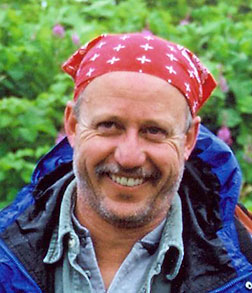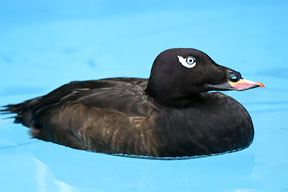The PAWS Perspective—John Huckabee—Winter 2007
This winter, COASST spoke with John Huckabee, a wildlife veterinarian with the Progressive Animal Welfare Society (PAWS), to learn more about their mission to advocate for animals through education, legislation, and direct care. PAWS is one of the largest wildlife rehabilitation centers in the Pacific Northwest. More than 3,000 animals come through the doors annually, many of them seabirds.

John Huckabee, Wildlife Veterinarian, PAWS. (Courtesy of J. Huckabee)
COASST: How long have you been a wildlife veterinarian?
HUCKABEE: By 1991, I was able to work exclusively as a wildlife veterinarian. I worked closely with wildlife rehabilitators after graduating from vet school in 1985. In March of 1998, I moved to Washington to work with PAWS because their mission aligned closely with my own: to release wildlife back into their natural habitat and help create long-term solutions to conflicts between humans and their wild neighbors.
COASST: You really seem to enjoy what you do for a living. What is it about PAWS that appeals to you? What parts of your job do you most look forward to?

Many of you will remember all of the Western Grebes washing up last year—these are a few that were treated at PAWS and successfully released. (Courtesy of PAWS)
HUCKABEE: The best part of my job at PAWS is coming to work every day knowing that I will encounter something different. Because we see so many types of birds and mammals, it is impossible to anticipate what the next phone call will bring. Every day is full of new and exciting challenges. Animals in the center are stressed by their injuries, not to mention the trauma of capture and handling, so my greatest joy is being able to see them released in a health condition.
COASST: COASST has recorded 95 seabird species since we started in 1999, with murres and fulmars topping the list. What are some of the most common seabird species you see at PAWS? What are the rarest species?

This lone White-winged Scoter, blown onto the beach in a big storm, spent some time recuperating at PAWS. (Courtesy of PAWS)
HUCKABEE: We see an average of about 70 individuals each year. The most common are gulls–mostly Glaucous-winged Gulls–followed by Common Murres and Western Grebes. Depending on the year and the alignment of the planets we get pulses of Northern Fulmars, Rhinoceros Auklets, Horned and Eared Grebes, and White-winged and Surf Scoters. Though the number and species of birds we treat varies, it reflects some major trends found by COASST. For instance, in the fall and winter of 2003-2004 (when nearly 80% of all COASST finds were fulmars) PAWS was also inundated with these emaciated tubenoses. But we have seen a few species COASST has not, including the Red-tailed Tropicbird and Wilson’s Storm-Petrel.
COASST: COASST uses beached birds as an indicator of coastal environmental health: while you work with live birds, we handle dead birds. That being said, are there points of connection between our programs?
HUCKABEE: COASST allows us to see the big picture by providing us with information about seabird mortality events. For example, in March of 2005, we used COASST data at the National Wildlife Rehabilitator’s Association annual symposium to stress the magnitude and geographic extent of the fulmar die-off in 2003. Organizations like COASST help PAWS recognize whether species coming into the center are part of some natural mortality peak, or whether there is cause for alarm.